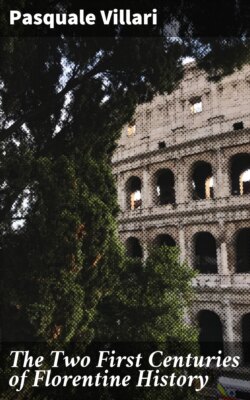Читать книгу The Two First Centuries of Florentine History - Pasquale Villari - Страница 24
На сайте Литреса книга снята с продажи.
I.
ОглавлениеTable of Contents
AFTER Countess Matilda's death the envoys despatched from Germany to reassume the margraviate of Tuscany in the name of the Empire followed one another in rapid succession.145 But almost all were men of small ability, pursuing a vacillating policy that led to no results. They tried to exercise the power of margraves, but were merely temporary officials of the emperor. Without resources, without knowledge of the country, they relied now on this party, now on that, incapable of distinguishing friends from foes, and never understanding the causes of the wars continually breaking out on every side. This state of things, well adapted to promote communal independence, lasted to 1162, when Frederic Barbarossa began to make the weight of his hand felt by initiating a clearer and more determined policy, although even his talent failed to obtain any notable results.
The Florentines were those best able to profit by the weakness of the Empire. In 1129 they took possession of the Castle of Vignalo in the Val d'Elsa;146 and in 1135 destroyed the stronghold of Monteboni, belonging to the Buondelmonti, whose name was derived from it, and who were now forced to submit to the Commune, yield it military service, and dwell in the city a certain part of the year.147 On this head Villani remarks that the Commune now began to extend its borders "by violence rather than by reason, … subjecting every noble of the contado, and demolishing fortresses." This was, in fact, the policy of Florence, and it led to two inevitable results. An increase of territory was the first; the second, that the always-increasing number of nobles brought into the city paved the way for the formation of an aristocratic party opposed to the people, and consequently promoting civil strife and future changes of government.
In June, 1135, the Imperial envoy Engelbert entered Florence, and seemed amicable to the Commune.148 He speedily moved on to Lucca, where he met with a serious defeat. The succeeding envoy, Errico of Bavaria, came with a considerable force, and appeared ill-disposed towards the Florentines. His stay, however, was short, and his successor, Ulrico d'Attems, showed friendly intentions, and in 1141 even aided the Florentines in a skirmishing expedition against Sienna.149 But all these envoys came and disappeared like meteors. Florence was now beginning its great war with Count Guido, surnamed the Old, who had become their foe. A contested inheritance served as a pretext for the rupture; but the real cause must have lain in the increased power and menacing attitude of the count. His possessions hemmed in the Republic on all sides, and Sanzanome said of him, "Per se quasi civitas est et provincia."150 The citizens first seized a castle of his near Ponte a Sieve, and then attacked his stronghold of Monte di Croce. But, aided by neighbouring towns, the count succeeded in defeating the Florentines on June 24, 1146. Nevertheless, they contrived even then to extort advantageous terms, namely: that part of the walls should be dismantled, and that the castle should hoist the banner of Florence.151 All this was done, and there was truce for a time, while the count seems to have been engaged on distant expeditions. But later, the walls were restored, and thereupon the Florentines,152 declaring that the agreement had been violated, suddenly stormed the castle in 1153, and rased it to the ground. And thus, wrote Sanzanome, "Mons Crucis est cruciatus." Certainly all this could not lead to peace. Count Guido ceded part of Poggibonsi to the Siennese on condition of their fortifying and defending it against the Florentines, who were preparing to make an assault. By accepting the gift Sienna stood pledged to play an active part in the war, which thus continued to spread.153
